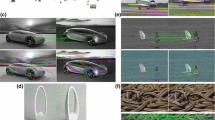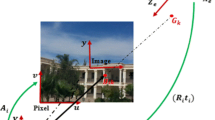Abstract
We describe a new algorithm for the obtainment of the affine and Euclidean calibration of a camera under general motion. The algorithm exploits the relationships of the horopter curves associated to each pair of cameras with the plane at infinity and the absolute conic. Using these properties we define cost functions whose minimization by means of general purpose techniques provides the required calibration. The experiments show the good convergence properties, computational efficiency and robust performance of the new techniques.
Similar content being viewed by others
References
Armstrong, M., Zisserman, A., and Hartley, R. 1996. Self-calibration from image triplets. In European Conference of Computer Vision, pp. 3–16.
Maybank, S. and Faugeras, O. 1992. A theory of self-calibration of a moving camera. International Journal of Computer Vision, 8(2):123–141.
Faugeras, O. 1993. Three-Dimensional Computer Vision: A Geometric Viewpoint. MIT Press: Cambridge, Massachusetts.
Fusiello, A. 2000. Uncalibrated Euclidean reconstruction: A review. Image and Video Computing, 18:555–563.
Hartley, R.I. 1994. Projective reconstruction and invariants from multiple images. IEEE Trans. on PAMI, 16(10).
Hartley, R.I. 1998. Chirality. International Journal of Computer Vision, 26(1):41–46.
Hartley, R.I. and Zisserman, A. 2000. Multiple View Geometry in Computer Vision. Cambridge University Press: Cambridge, UK.
Hartley, R.I., Haymann, E., de Agapito, L., and Reid, I. 1999. Camera calibration and the search for infinity. In Proceedings of the International Conference on Computer Vision.
Maybank, S.J. 1990. The projective geometry of ambiguous surfaces. Philosophical Transactions: Physical Sciences and Engineering, 332(1623):1–47.
Maybank, S.J. 1993. Reconstruction from Projections. Springer-Verlag: Berlin.
Nister, D. 2001. Calibration with robust use of cheirality by quasiaffine reconstruction of the set of camera projection centres. In Proceedings 8th IEEE International Conference on Computer Vision. ICCV 2001, vol. 2, pp. 116–123.
Pollefeys, M. and Van Gool, L. 1999. Stratified, self-calibration with the modulus constraint. IEEE Trans. on Pattern Analysis and Machine Intelligence, 21(6):707–724.
Press, W.H.et al. 2002. Numerical Recipes inC⋭⋭++: The Art of Scientific Computing, 2nd ed. Cambridge University Press: Cambridge, MA.
Quan, L. and Lan, Z. 1999. Linear N-point camera pose determination. IEEE Transactions on Pattern Analysis and Machine Intelligence, 21(8):774–780.
Schaffalitzky, F. 2000. Direct solution of modulus constraints. In Proc. Indian Conference on Computer Vision, Graphics and Image Processing, Bangalore.
Semple, J.G. and Kneebone, G.T. 1998. Algebraic Projective Geometry. Oxford Classic Texts in Physical Sciences, Oxford University Press: Oxford.
Seo, Y. and Heyden, A. 2000. Auto-calibration from the orthogonality constraints. In International Conference on Computer Vision, Barcelona, Spain.
Triggs, W. 1997. Auto-calibration and the absolute quadric. In Proc. IEEE Conference on Computer Vision and Pattern Recognition, pp. 609–614.
Author information
Authors and Affiliations
Rights and permissions
About this article
Cite this article
Ronda, J.I., Valdés, A. & Jaureguizar, F. Camera Autocalibration and Horopter Curves. International Journal of Computer Vision 57, 219–232 (2004). https://doi.org/10.1023/B:VISI.0000013095.05991.55
Issue Date:
DOI: https://doi.org/10.1023/B:VISI.0000013095.05991.55




